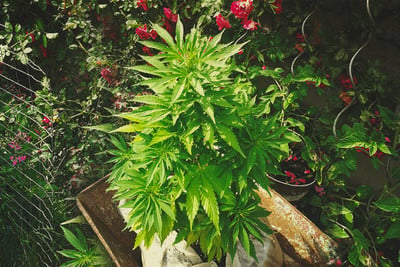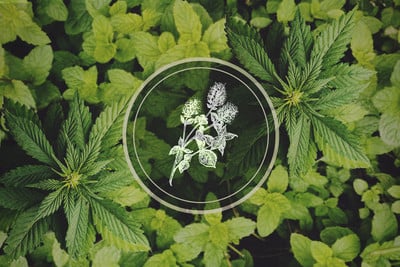.

Companion Planting For Cannabis: What You Need To Know
Growing cannabis plants alone leaves them exposed to pests and the elements, and it can leave the soil depleted as well. If you grow companion plants nearby, though, you'll not only be able to fend off pests, but bring in beneficial insects and introduce key nutrients to the soil as well. Here, we'll be discussing how they work in close detail.
Companion planting will transform your garden and help your weed plants thrive.
For the most part, cannabis plants do well when grown as a monocrop (meaning it’s the only plant in a given area). As it goes in nature, though, they grow much better when surrounded by certain species of other plants. These helpers, known as companion plants, fulfil a variety of critical roles in the garden and grow room, from keeping insect pests away to driving vital nutrients into the soil.
Read on to discover the fascinating world of companion planting, and see why you should be partaking in this ancient practice.
Contents:
What is Companion Planting?
As we’ve implied, companion planting involves growing beneficial plant species in close proximity to—or even among—your cannabis plants. These species offer myriad benefits to your growing operation, hence why they’re referred to as “companions”.
Some plants attract useful pollinators and predatory insects, others keep your cannabis hidden away, while different kinds pull in nitrogen from the atmosphere. As they take root with your crop, the resulting polyculture resists disease far better than a conventional monoculture. The cannabis you harvest will be higher-quality, too!
An Ancient Practice: the History of Companion Planting
The practice of companion planting is almost as old as agriculture itself, dating back thousands of years. As farmers tried growing new crops, they realised the benefits of growing symbiotic plants together. They saw their yields increasing and the health of their plants remaining stable, all while saving space.
Around 6,000 years ago, Native Americans began practising a companion method known as the Three Sisters. This trio—consisting of corn, squash, and beans—was found to bring the best out of each other.
The corn grows tall and pole-like, providing ample shade for the squash and a climbing frame for the beans. The squash then develops large leaves that block sunlight from directly hitting the soil, preserving microbial life. In turn, the beans, being legumes, work with said soil-dwelling microbes (rhizobia) to fix nitrogen from the atmosphere—a vital nutrient.

The Benefits of Companion Planting: a Permaculture Principle
As you can see, companion planting can transform your garden into a complex web of life that sustains and benefits itself. Given that, the practice is consistent with the idea of permaculture, which suggests agricultural systems should be sustainable and self-sufficient.
Permaculture also places a huge emphasis on closed-loop systems. These systems aim to keep the flow of resources within the boundaries of a farm or garden. With that in mind, companion planting helps achieve a closed-loop system by providing food, herbs, compost, and atmospheric nitrogen.
Let’s dive in a bit deeper to see how these benefits pan out.
🏞️ Biodiversity
Of course, growing different species of plants in close proximity will greatly enhance the biodiversity of your garden. This biodiversity creates a superb environment for soil microbes to thrive—one of the keys to developing healthy cannabis plants.
Increased biodiversity in the form of flowers, shrubs, and vegetables also provides a safe haven for beneficial wildlife and pollinators. In turn, this variety helps reduce instances of disease transmission. In contrast, large, densely packed monocultures are notorious for catching fast-spreading pathogens. Since the plants are all the same, they’ll autumn victim to the same illness. Companion plants fix this by creating a buffer between the main crop and disease.
💚 Protection
Companion plants do attract wildlife, but not all kinds. In fact, they also help deter animals and pests that can do real damage to your cannabis plants.
Many species of companion plants release pungent aromas into the air and act as natural insect repellents. Other species take an opposite approach, looking far more attractive in the eyes of insects. Instead of driving pests out of the garden, they steal their attention and divert them away from your weed plants.
Larger species—especially those grown as barriers—can also protect your cannabis from harsh weather. Tall sunflowers and tomatoes, for instance, can act as windbreaks to prevent any stems from snapping during storms.
🌱 Soil Health and Nutrients
Healthy soil sets great cannabis growing operations apart from good ones. Just below the surface of the soil is the rhizosphere, a community of micro-organisms that attach themselves to the root systems of plants, helping them to absorb nutrients from the soil necessary for their growth. The roots then release sugary exudates and attract all manner of bacteria and fungi.
These species help plants access nutrients in various ways. Mycorrhizal fungi, for one, fuse with plant roots and help them obtain nutrients in return for sugars. Bacteria love the taste of these sugars, too. As a result, when they eventually die, they release many nutrients in close proximity to the roots.
Polycultures are particularly great at sustaining these microbial colonies. Cover crops guard them from the sun, and other companions add exudates into the soil, creating a thriving food web. Nitrogen-fixing plants also ramp up soil health and accelerate growth. Specifically, they work with bacteria in the soil to pull nitrogen from the atmosphere and into the soil.
🍃 Food and Natural Remedies
Perhaps one of the best benefits of this growing strategy is that some companion plants even produce food! To us, nothing beats the satisfaction of cooking up food from your own garden, especially when you have the munchies.
Other plants can be used in soothing teas, tonics, or cosmetics such as lotions, balms, and tinctures.
Effective and Popular Companion Plants
There are hundreds of companion plants to choose from, and thousands of combinations. When planning your polyculture, be sure to check which plants are compatible and which are not. Some plants thrive together, whereas others simply don’t get along.
With that being said, these are some of the most effective companion plants out there, categorised by type.
Cover Crops
Cover crops improve the structure of the soil, manage nutrients, and help protect microbial populations.
Nasturtiums:
|
Comfrey:
|
Alfalfa:
|
Sweet peas:
|
|
Nitrogen Fixers
These species pull large amounts of nitrogen—a macronutrient required for photosynthesis and protein building—into the soil. However, they don’t do this all on their own, teaming up with specialised soil-dwelling bacteria to get the job done.
Yarrow:
|
Dandelion:
|
|
|
Beans:
|
|
|
Clovers:
|
Deterrents
Deterrents produce cocktails of terpenes with pungent aromas that make pests think twice before munching on your cannabis plants.
Lemon balm:
|
Lavender:
|
Coriander:
|
Mugwort:
|
|
Catnip:
|
|
|
Attractors
Attractor companion plants, as we’ve explained, draw pollinators and other beneficial insects into your garden. These critters will help bring down pest populations, fertilise your fruits and vegetables, and increase overall yield.
Thyme:
|
|
|
Fennel:
|
|
|
Dill:
|
Food and Herbs
Besides increasing biodiversity and attracting beneficial insects, these plants will be among the tastiest in your garden.
Onion:
|
|
Rosemary:
|
|
Borage:
|
Sage:
|
|
|
Get Started With the RQS Guardians Pack
Now that you know all the benefits of companion plants, it’s time to spruce up your cannabis garden! The Royal Queen Seeds Guardian Pack contains a range of species that will form a defence fortress around your cannabis plants. They’ll do wonder for your garden’s biodiversity, too!









































